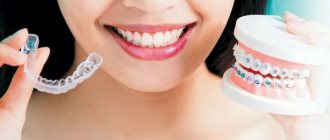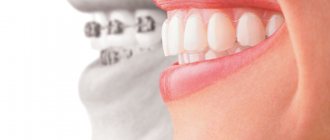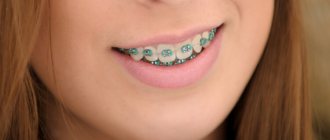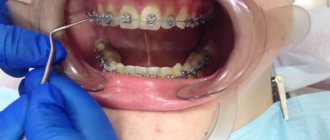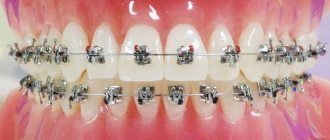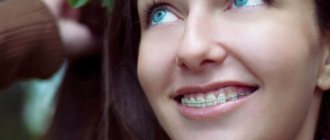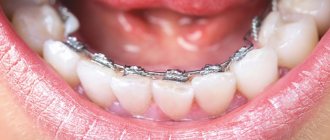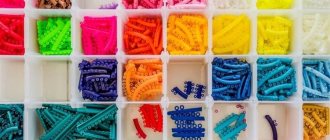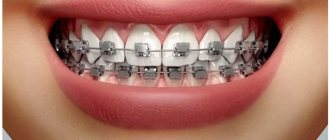July 16, 2020 Last revised: September 13, 2020 Bite correction
In orthodontics, plates or braces are most often used to correct bite pathologies. These two types of structures successfully cope with the task assigned to them, but they are very different from each other in type, purpose, price, etc. Therefore, many patients are concerned with the question, which is better to use for braces or plates to correct the bite? Only through comparison will each patient be able to decide on the choice of the system that is suitable for him.
Differences in the design features of plates and braces
These two systems are used in orthodontics to align, anchor and correct teeth. Despite the fact that they have the same task, they are very different in their design.
The plates are removable systems. After its installation, the patient still has the opportunity to independently put on and remove the structure when he needs it. For example, if you need to attend a business meeting, wedding, birthday, etc. Special plastic is used in the production of plates, but the structure itself also contains metal elements, various screws, springs and arcs.
Braces are intended for more stringent treatment and are non-removable systems. Each small bracket-lock is fixed on a dental unit so as to remain in its proper place. Most often, these clasps are made of ceramics and are practically unnoticeable on the teeth, but a metal arc passes through each such clasp, which greatly reduces aesthetic performance. The patient has to adjust psychologically. After all, the entire course of such treatment will last for a minimum period of a year. Throughout this period, the structure will be visible to others, and it cannot be removed independently.
Types of dental plates
Some people do not distinguish between these two designs, but plates and braces are not the same thing. Despite the fact that they have the same purpose, they have significant differences.
Braces are a complex consisting of several elements that are connected to each other. They ensure an uninterrupted process of correcting the curvature of the dentition and bite. The orthodontic device is non-removable and is worn for a fairly long time.
The plates are also a non-removable device. They seem to encircle the teeth. Plates can eliminate any problems regarding the jaw. Compared to braces, they look bulkier and cause more discomfort when worn.
The use of plates is resorted to when treating the problem does not take much time. Another significant difference is the cost: installing braces will be much more expensive.
For more serious pathologies of the dentition and bite that require long-term treatment, you should give preference to braces. If, in the opinion of the dentist, the dentition is slightly crooked and it will take little time to eliminate the problems, it is better to use plates. Plus, they will be much cheaper.
Plates are the most affordable and common designs for people with malocclusion. They are cheap, do not cause pain or discomfort, and effectively cope with the problem. During the treatment process, you can independently monitor the gradual disappearance of uneven teeth.
Below we will consider a different classification of plates.
| View | Description |
| Single jawed | Placed on one jaw. They are used for changes in individual teeth, reduction and narrowing of the dentition. The base consists of a plate and screws. When tightening the screws, pressure is applied to the teeth, under the influence of which they straighten. They can be used by both children and adults |
| Bimaxillary | They are installed on two jaws and cope with serious dental defects. |
| With retraction arch | Relieves problems with front teeth. |
| With a hand-shaped process | Eliminate defects in problem teeth individually. The plate is placed on one jaw, the process presses on the tooth, as a result of which it moves in the required direction. |
| With pusher | With the help of springy elements they only deal with problems of the upper jaw. |
| Brückl's design | Corrects the bite of the anterior teeth of the lower jaw. |
| Frenkel apparatus | Represented by a metal frame. There are many elements connected to it. Able to cope with even the most serious malocclusions. |
| Andrez-Goipl apparatus | Consists of two combined parts that fit onto both jaws. It has a universal effect and is able to cope with several dental defects at once. |
The records are also divided according to their functionality.
Such plates have a positive effect on the processes of chewing and swallowing, affect the formation of the correct size and shape of the jaw, and control the level of muscle tension.
The fact is that the tongue puts pressure on the dentition, which contributes to the formation of a malocclusion. What is the essence of a functional apparatus? It helps the tongue take the necessary position in the oral cavity and prevents pressure on the teeth. It is usually worn for up to a year. During this time, the tongue gets used to the correct position due to muscle memory, which, even after removing the device, helps it remain in the desired position.
What happens if you fix a dental problem with braces? In any case, a relapse will occur.
The latest advanced orthodontic equipment allows you to move your teeth without any problems. But initially it is worth carrying out preparatory work with the language, otherwise the original situation will return. The tongue is not ready to so abruptly accept the fact that its rightful space will be significantly reduced, so it will begin to fight with the teeth in order to force them back.
To maintain the new position of the teeth, care must be taken to create favorable conditions in the oral cavity and protect them from external pressure. This is the most striking example of the use of a record. If bite problems arise, only an experienced specialist, and not the patient, can correctly determine the treatment method.
The purpose of such plates is to simply mechanically move the dentition. They are superior to braces due to their low price. If we are talking about malocclusion in an adult, then things will be much more complicated. It is difficult to move teeth using mechanisms; you can only change their inclination.
Braces are a complex system consisting of several small clasps that are firmly attached to the teeth. To install them, doctors use a special adhesive base that releases fluoride, which performs a protective function in relation to the enamel from the loss of mineral components.
Depending on the type of braces you choose, your smile will vary. Some prefer metal classic devices, others agree to correct their teeth only if the braces do not catch the eyes of those around them. For teenagers, installing braces is another way to emphasize their individuality, as the doctor can offer shaped or colored devices.
Modern dentistry uses several types of braces, which are produced in Russian cities and abroad. The vestibular and lingual apparatuses differ in location. The first ones are attached to the front part of the dentition, which makes them noticeable, but no less aesthetic. Their cost is a little less, the end result is more pleasing, and they do not require prolonged wear to correct the dentition. The latter are attached to the back of the teeth, making them invisible to people.
The braces retainer can be direct or indirect. With direct bonding, braces are placed on each tooth. Indirect fixation is considered a faster method. To do this, a plaster model of the teeth is made, to which braces are attached, connected by aligners, as a result of which they are quickly and easily transferred to the patient’s dentition.
Until recently, doctors installed only classical devices, in which the ligature acted as a fixator. In modern medical institutions, non-ligature braces are used. They are held on the arch with a clip. This type allows you to quickly correct uneven teeth.
Non-standard types
Braces keep getting better. According to rumors, magnetic braces are being developed in Oxford laboratories. It is possible that in the near future they may begin to be sold on the medical products market. But for now, unusual varieties include curly, multi-colored and self-adjusting braces.
They are used under different circumstances. It is better to put braces on people who have permanent teeth (children, teenagers, adults). Plates are usually used for uneven baby teeth or when they begin to change.
But there are cases when records are also played for an adult. This may be affected by the diagnosis and some reasons. But plates will not give the desired result in straightening permanent teeth, so it is better to choose braces.
DETAILS: How teeth are straightened with braces
The plates are most often used by children, sometimes by teenagers. They will be of little benefit to adult patients. It is better to wear plates when the bite changes. Replacement of primary teeth usually occurs at age 11. At this age, some pathologies may develop. Sometimes a permanent tooth does not begin to grow in place of a fallen molar for some time. In this situation, nearby teeth will help move in his direction, which causes defects.
Braces can be placed at any age. Due to their strong pressure, the most severe bite problems can disappear. However, age affects the length of time you wear braces. The older the person, the longer the treatment will take. Usually, at the age of 25 years and older, the active development of teeth and the entire jaw stops, metabolic processes slow down, and it can take 3-5 years to correct the bite. Before this age, there is a chance to get rid of problems in a shorter period of time.
The difference between braces and staples is already clear; now it remains to determine which design option is preferable to install. Only the characteristics of each product will help you make your choice. The following points are characteristic of staples:
- simplicity of design;
- the product is oversized and uncomfortable;
- must be worn on the teeth;
- the cost of staples is much less, and they must be used for short-term therapy;
- may not be used in all cases;
- their use requires more frequent visits to the dentist in order to replace it from time to time;
- It will be easier to perform hygiene procedures.
The following points are typical for braces systems:
- this system includes several parts;
- braces have a neat, neat appearance;
- their fastening is carried out on cement;
- non-removable structures can be used for various pathologies of the jaw.
What is better than staples or braces for correcting an overbite? Of course, braces. These structures are non-removable, and their long-term wear is the key to success. In addition, they can be used to treat various abnormalities and successfully eliminate them. As for braces, this option should be used only when there is a simple pathology, and the process of correcting the bite does not require long-term treatment.
- the cost of fixed models is higher, but the treatment is also more effective;
- removable plates can be removed at any time, and people around you may not realize that you have them;
- Removable braces, unlike fixed ones, are completely ineffective for severely crooked teeth.
- It is necessary to change the shape of the jaw bones.
- There is a need to keep teeth in the correct position.
- To correct the width of the palate.
- Plates prevent tooth movement.
- They can be used to inhibit or stimulate jaw growth.
- If it is necessary to consolidate the result achieved with braces.
- Single jawed. They contain orthodontic screws and a plate base. Screws can be used to adjust the pressure on the teeth. Most often they are used in the presence of single tooth deformations or if it is necessary to expand or lengthen the dentition. Such plates can be used not only in children, but also in adults.
- Hand plates are used to correct the crooked position of individual teeth. A plate for straightening teeth, as the photo demonstrates, is placed on one of the jaws, and the appendage puts pressure on the tooth and helps it move in the desired direction.
- If it is necessary to correct the protrusive position of the anterior teeth, plates with a retraction arc are used.
- Push plates are only suitable for the upper jaw to correct palatal alignment.
- The Brückle appliance is worn to correct teeth malocclusion in the lower jaw.
- The Andresen-Goipl activator consists of two components, which are placed on two jaws at once and have a combined effect on correcting several pathologies in the structure.
- The Frenkel apparatus has the most complex structure. It includes cheek shields, lip pads and several additional parts connected into a single whole using a metal frame. Such devices are used to eliminate mesial, distal and open bites.
- Visit an orthodontist.
- Make impressions of the jaw.
- Undergo an X-ray examination.
- Visit a doctor to try on plaster models of future plates.
- If the plaster model fits (and it should fit perfectly), the real plate is made from it.
- They are quite easy to care for; even a child can cope with this task.
- Installation does not take much time and is completely painless.
- Visually, plates are less noticeable than braces.
- Typically, your doctor will allow you to remove the plates before eating, brushing your teeth, or allow them to be worn only at night. It all depends on the degree of the defect. This gives rest to the dental system and is not so difficult to perceive morally.
- A brace helps correct not only the position of the teeth, but also the shape of the jaw bone of the skull.
- Wearing plates quickly eliminates the gap between teeth.
- The bite and palate width are quickly adjusted.
- If there are serious and complex defects in the dental system, then it will not be possible to correct them with the help of plates.
- Since it is possible to remove such a structure, a loophole appears to somehow violate the doctor’s instructions, and such neglect can nullify the entire treatment.
- Plates are also not suitable for correcting defects in adults, since they are not capable of moving teeth.
- After each meal, it is necessary to rinse your mouth or brush your teeth, and no one has canceled morning and evening brushing. This is necessary to prevent the accumulation of bacteria on the structure and teeth, which can lead to the development of caries.
- The plates must be cleaned with special gels, and you must have two of them: for everyday use and for deep cleaning. The cleaning process should be carried out with a toothbrush, but not too hard, so as not to damage the structure.
- Approximately once every 7 days, the plate should be placed in a special solution overnight.
- It happens that as a result of prolonged wear, tartar appears on the plate, which cannot be eliminated by the above means. In this case, you need to contact a specialist and have the structure cleaned.
- After cleaning, you need to drip a little vegetable oil onto the plate screw and turn it in different directions.
- In order not to contaminate the plate again, it is better to remove it before eating.
- You cannot remove the plate before going to bed, the entire therapeutic effect will be reduced to zero. Parents especially need to monitor this if they have plates to straighten children’s teeth.
- remove orthodontic appliances when eating and brushing teeth;
- removing plaque from the surface of the enamel and plate. If it is impossible to remove it yourself, the structure should be taken to the dentist;
- brush your teeth 2 times daily per day, and after meals, rinse the mouth;
- The structure is cleaned with a special gel daily using a soft brush. Deep cleaning should be carried out 1 r. per week - the device is placed in a solution of chlorhexidine or hydrogen peroxide;
- place the product in a special well-ventilated container and leave it in a disinfectant solution overnight, if the doctor has allowed it to be removed during this period;
- Before each subsequent installation, it is necessary to rinse the device with warm boiled water;
- during sports activities, it is also recommended to remove the product from the oral cavity to prevent the possibility of its breakage;
- the adjustment screws are lubricated daily with oil (apply 1 drop), and then scrolled in different directions;
- do not neglect scheduled visits to the dentist to carry out the correction and determine the effectiveness of its impact;
- Once a quarter you need to visit a doctor to have your mouth cleaned;
- If an orthodontic device breaks, you should immediately contact your dentist.
The difference in a possible solution to a bite problem
A plate made of plastic cannot affect teeth under heavy load. Therefore, she is unable to correct severe bite pathologies. The indication for the use of plates is the presence of slightly identified defects in the bite or fixation of dental units in the correct position in advance. For example:
- The teeth are positioned correctly, but there is a risk of their displacement. The plate will help prevent this process.
- The teeth have just begun the process of moving into the wrong position.
- The shape of the jaw bones begins to change. The plate has the ability to stimulate (or inhibit) this growth.
- The design is also well suited for correcting the width of the palate. The correct development of the bite in the future will depend on the size of the palate.
From the indications for the use of removable systems, we can conclude that plates are an ideal opportunity to avoid the development of occlusion pathology in the future.
One of the main elements of the braces system is the arch. It is made of a dense metal alloy and has its own shape memory. Due to this, strong continuous pressure is exerted on the dental units. This helps to overcome serious problems in the development of bite and even congenital pathology.
For example:
- Pathology associated with improper development of the jaws.
- The center line of the incisors is displaced.
- Incorrect position of one or more teeth, associated with their strong displacement.
- The profile of the face was deformed.
- Impaired facial asymmetry.
- The tooth root develops in the wrong direction.
- Shortening or lengthening of teeth.
Braces systems help prevent the development of bite defects and correct already formed pathologies. The presence of defects in the dentition sometimes cannot be corrected using plates. And if the orthodontist insists on installing a braces system, you should not question his decision. The choice between these two systems disappears by itself.
Price difference
The price for installing plates and braces varies greatly, which greatly influences the client’s choice.
Cost of installing braces:
- Sapphire braces will cost you between 85 and 175 thousand.
- Metal bracket systems - from 36 thousand to 107.
- Ceramic braces systems - from 56 to 133 thousand rubles.
We suggest you read: Why you need to wear rubber bands on braces
Keep in mind: unlike braces, plates will not cause any special expenses; their installation will cost you around three thousand rubles.
Thus, from all that has been said, we can summarize. If you want to install a system with good aesthetic characteristics and the duration of treatment does not scare you, choose plates.
But remember that they do not solve complex malocclusion pathologies. Braces are the most reliable option. Of course, they are more expensive, but the effect of them will be noticeable after a couple of weeks of wearing the system.
Braces or plates, which is better depending on the patient’s age
The use of plates is prescribed at the initial stage of defect development. These systems are unable to change the position of the tooth; they can only hold it or slightly guide it. Therefore, these designs are more often used in pediatric dentistry. The best period for using these systems is the stage of development of the mixed dentition. Basically, this period occurs at the age of twelve, when the primary incisors are intensively replaced by permanent ones. This age is at the highest risk of developing pathology. This is especially true in cases where the baby incisor has already fallen out, and the permanent one is in no hurry to replace it. Then all adjacent units begin to shift towards the resulting space, giving rise to the development of defects in the dentition.
In adult dentistry, plates are often prescribed to fix a positive result after successful treatment of pathology with braces.
Things are completely different with braces systems. These designs can be used for any age category of patients. They are successfully used in pediatric dentistry to correct significant bite pathologies, and no less successfully in adults.
Due to their harsh impact, braces are able to correct the most serious disorders in the dental system. The only thing that the patient's age can affect is the duration of treatment. The younger the patient, the more the course of treatment is shortened. For example, up to the age of 25, the dental system is in its intensive development, so pathology is corrected more effectively. The terms vary from 6 months to one and a half years. After 25 years, development stops. Stopping the growth of bone tissue and slowing metabolic processes lead to the fact that the period for correcting defects increases to three years. In some cases, the result obtained has to be recorded for life.
When are braces and plates used?
There are certain indications for treatment with both braces and plates. Let's start with the fact that braces are used for people with permanent teeth, that is, they are best suited for older children, teenagers and adults. Plates are most often used in pediatric practice (in primary, mixed dentition and in the initial stages of the formation of a permanent dentition).
Of course, there are exceptions when the plate may well be applicable to an adult. It all depends primarily on the diagnosis and some other factors. However, more often with a permanent dentition, the plate is less effective compared to braces, so the best result will be achieved when the occlusion is corrected with the latter.
We will consider a situation where both braces and a plate can be successfully used to treat any orthodontic pathology. That is, when both devices can cope with the task.
I think that only in such a situation will it be legitimate to compare these two systems and, finally, determine what is better - braces or plates.
How to straighten teeth without braces - all about options for straightening your bite without using a braces system. Which braces are best to install - advice from an orthodontist.
Differences due to system care
The plates are more maintenance-free. To carry out high-quality oral hygiene, it is enough to remove the structure. The whole procedure consists of the usual brushing of teeth and cleaning the plate itself. To carry out the procedure, you will need a toothbrush that has soft bristles and an antibacterial cleaning agent (paste).
There will be more problems with braces systems. The structure cannot be removed, which means the entire procedure must be carried out very carefully to avoid damage. To carry out high-quality hygiene you will need:
- Special brush.
- Gentle fluoride paste.
- Irrigator.
- Dental floss.
- Antibacterial rinse.
Additional cleaning of both structures must be carried out in dentistry. Typically this procedure is repeated every 6 months. The same deadlines are observed for assessing the quality of treatment and inspecting the system for damage.
Pros and cons of both systems
To make it easier for the patient to choose between plates and braces, you can study the strengths and weaknesses of each design separately.
Positive aspects of the plates:
- Good aesthetic indicators.
- It is possible to remove and put on the structure yourself.
- A simple way to care for the oral cavity and the plate itself.
- Affordable price that a patient on a budget can afford.
Negative:
- The fact that the plate can be removed independently has its disadvantages. Many patients begin to abuse this, increasingly removing the system. For this reason, the time required to correct pathology increases significantly.
- The period of adaptation to the plates comes with certain difficulties. The patient's diction changes, and the first meals are difficult.
- If the plate is lost or broken, it will take time to restore it. This may negatively affect the entire treatment.
- Long treatment period (longer than with braces).
- The systems cannot help in moving the teeth in the desired direction.
Pros of braces:
- Such devices are non-removable. This improves the treatment process.
- The patient quickly adapts to wearing braces.
- The presence of damage can be eliminated by visiting the dentist.
- The most effective way to eliminate dental defects.
Negative:
- Difficult care and the need for a large number of additional funds.
- The price of braces systems is quite high.
Another disadvantage of braces is that the system is visible to others. But there are several nuances here. For shy teenagers, manufacturers have come up with multi-colored ligatures that you can independently select by color and thereby emphasize your image. Adults with a public profile can use braces, which are attached to the inside of the tooth.
So, let's compare these two orthodontic appliances
Pros and cons of records
- Their most important advantage from the point of view of patients (especially shy ones) is that they can be easily removed by yourself if necessary. For example, you have been invited to a wedding, a birthday, or a very important business meeting is planned, and so on.
- Easy to care for your oral cavity. It is enough to remove the plate and brush your teeth using the usual method.
- Cheap. Treatment with such a device is several times cheaper than correcting a bite with a braces system.
AGAINST records:
- It is not surprising, but the fact that the plate can be removed at any time has a negative effect on the treatment. Those who abuse this treatment take much longer, and sometimes do not achieve the planned result at all.
- Getting used to removable structures takes quite a long time. For a relatively long time, patients cannot learn to chew food well and speak clearly with the device in their mouth.
- If the device breaks down, it usually takes more time to repair it or make a new one. And this again slows down the treatment process.
- The duration of the entire period of orthodontic treatment will be longer than when using a brace system.
- With the help of a plate, teeth cannot be moved in all directions that are needed during treatment.
Pros and cons of braces
- I consider it necessary to attribute the “non-removable” nature of braces to their positive properties. After all, the patient’s teeth are constantly being impacted. Accordingly, the process of straightening the dentition is carried out more efficiently, and its duration is noticeably shorter.
- Getting used to braces is better and faster than getting used to plates. Diction is practically not impaired, and sometimes does not suffer at all.
- If some kind of “problem” occurs (a bracket comes off, a rubber band breaks, an arch comes out, etc.), it is usually resolved on the day of the orthodontist’s visit and the treatment is not interrupted.
- With the help of a braces system, bite correction occurs faster.
- Unlike plates, the braces system provides various types of tooth movement (in different directions). This will undoubtedly have a better effect on the outcome of the treatment.
DETAILS: How much does 1 brace cost?
